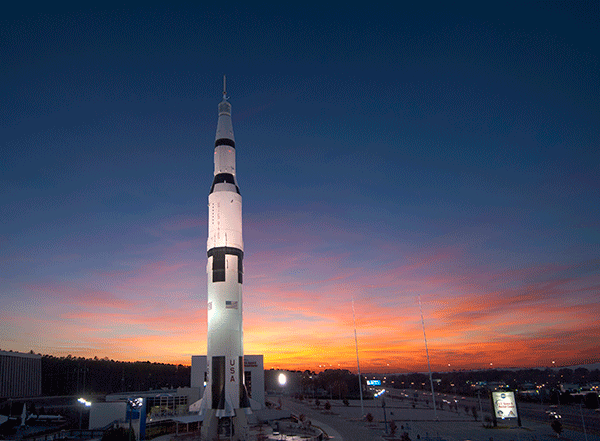
By Marilyn Jones
Every year, on August 19, National Aviation Day is observed in the United States to commemorate the history and development of aviation…and boy, does Alabama have a lot to celebrate!
It was in 1908, along the Flint River near New Market, when William Lafayette Quick’s mid-wing monoplane took flight. His 16-year-old son William was at the controls. This was the first airplane designed, built and flown in the state; the first to leave earth’s gravitational pull.
“He wasn’t in a race to be first,” says T. Gary Wick, a retired NASA aerospace engineer and the great-grandson of the inventor. “He was a designer; a contemporary of the Wright Brothers.”
Gazing up at the Quick Plane at the U.S. Space & Rocket Center in Huntsville Wick says the airplane is not a replica, but the restored plane his ancestor built. “I remember as a kid looking at it in [my great-grandfather’s] workshop.”
Made of wood harvested on the Quick’s farm and cut in his sawmill, and the metal forged in his blacksmith shop, the design allowed the pilot to be seated and had a three-wheel landing gear.

Construction began in 1900. Awaiting an engine, it took nearly eight years to complete. On its only flight, the airplane sustained damage to its right wing and gear when it landed.
“He learned from this experience and designed an ‘Improved Flying Machine,’” says Wick. “He patented in it 1912. It included other unique features including retractable landing gear and folding wings.
“And 50 years later I went to work for NASA,” Wick says with an easy smile.
Wright Brothers and Tuskegee Airmen
In 1910, as Quick was perfecting his monoplane, Wilbur and Orville Wright were opening the nation’s first civilian flying school on an old cotton plantation just west of Montgomery. Their idea was to train pilots for exhibition shows which, they hoped, would boost sales of their aircraft.
Although the school didn’t stay open long, the location was later used for aircraft repair during WW I and, in 1922, became Maxwell Field. Today it is the site of Maxwell Air Force Base.
Another significant aviation location is Tuskegee Airmen National Historic Site in Tuskegee.

It’s all here; the gate these young black men passed through during WW II when they arrived at the air base, the airplane hangars and the control tower. This was a time of segregation and these men weren’t allowed to be a part of the U.S. Army Air Force. Every black military pilot who trained in the United States — including five Haitians —were trained here.
They had a lot to prove; and they did. The first African American military aviators were highly decorated for their defense of this nation; their bravery and mission success.
Visitors to Hanger #1 first enter an orientation room where they can watch a short video of introduction before entering the sprawling museum which houses two World War II era training aircraft. Rooms around the outside of the hanger are set up as 1940s offices, training rooms and a coffee shop. The entire museum is like a time warp; visitors are suddenly transported back nearly 75 years. And the quiet, this chasm of time, remembers these men who served their country.
Aviation Museums
The Southern Museum of Flight in Birmingham is home to Alabama Aviation Hall of Fame. Exhibits feature several facets of aviation including Korean War jets, Vietnam War helicopters and Huff-Daland crop dusters.
The museum is one of the largest of its kind in the Southeast and is dedicated to presenting civilian, military and experimental aircraft and memorabilia from the earliest history of powered flight.
The United States Army Aviation Museumin Fort Rucker houses a collection of helicopters and airplanes that trace the development and use of aviation by the Army from troop and cargo transportation, to medical evacuations and scouting missions.
The museum is also home to the Army Aviation Hall of Fame and a Vietnam Memorial, and has the largest collection of helicopters held by a museum in the world.
Full Circle
Walking with Wick, past displays and artifacts at the U.S. Space & Rocket Center, it’s hard to imagine all that has been accomplished between 1918 when an airplane first to took the skies over Alabama and today.
Huntsville is where the space program was born. Men and women from Alabama, like Wick, and others from across the nation and around the world worked together to develop rockets that put the first U.S. satellite into orbit and sent men to the moon; where the power of the space shuttle was developed; where the modules for the International Space Station were designed and built; and where the Space Launch System is being designed.
Yes, Alabama has a lot to celebrate on August 19 and all year round; its aviation history is legendary.
For more information:
U.S. Space & Rocket Center; 1(800) 637-7223; rocketcenter.com
Tuskegee Airmen National Historic Site; (334) 724-0922; www.nps.gov/tuai
Southern Museum of Flight; (205) 833-8226; www.southernmuseumofflight.org
United States Army Aviation Museum; 1(888) ARMY-AVN; www.armyaviationmuseum.org




